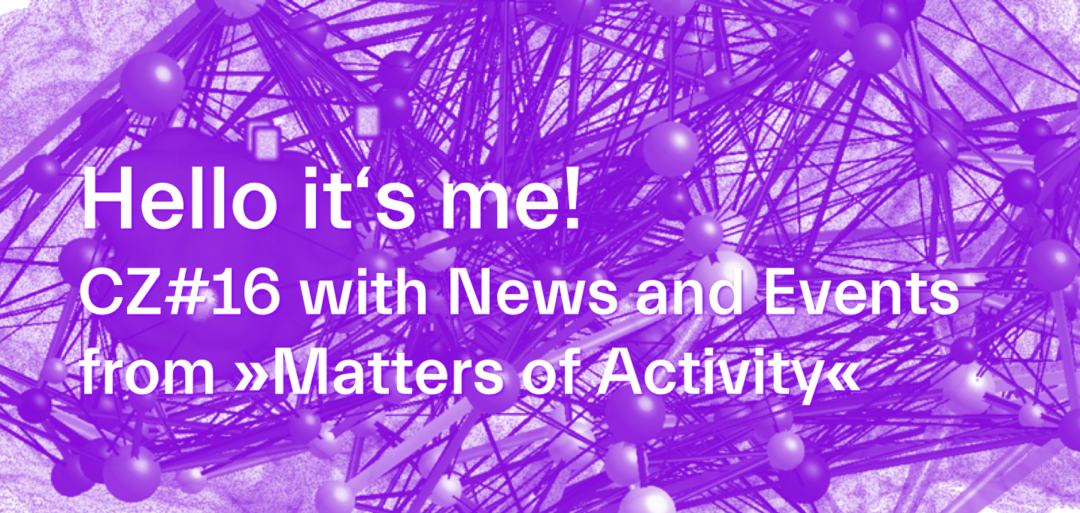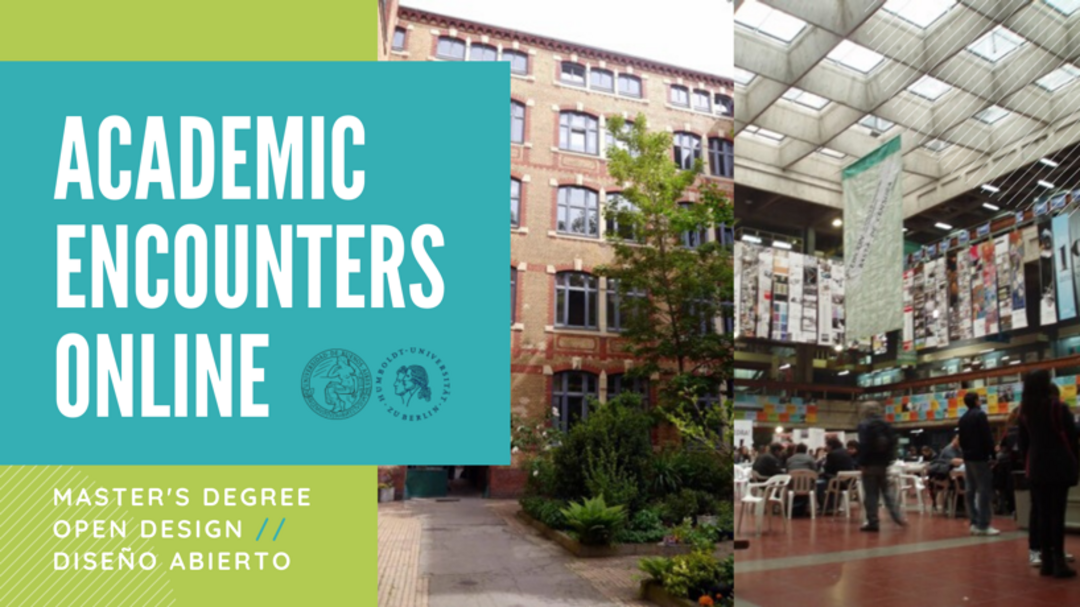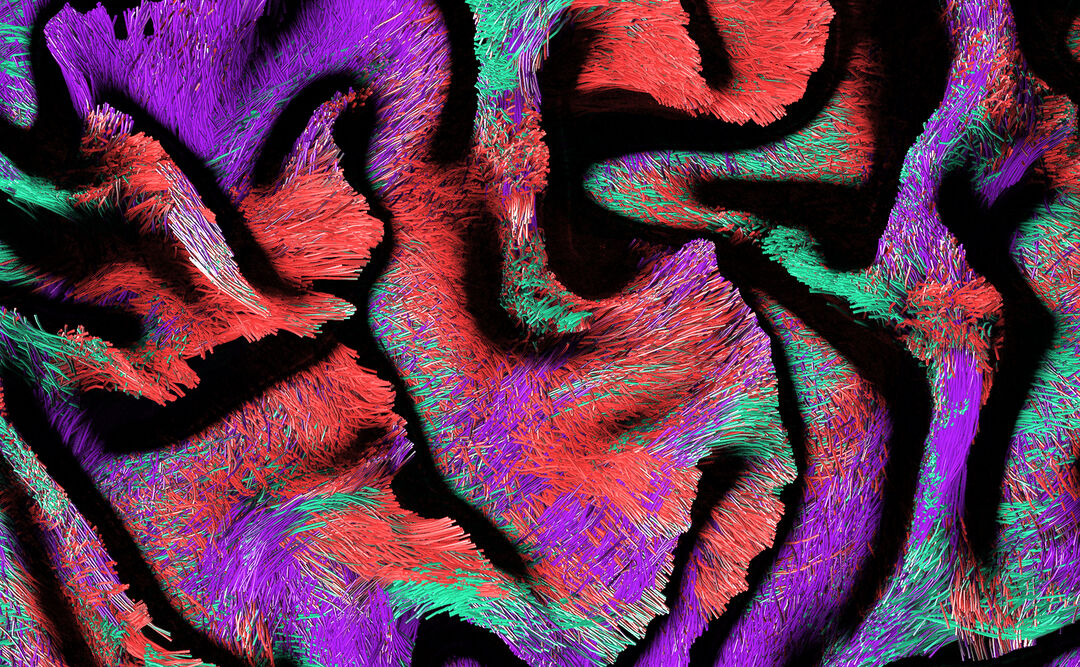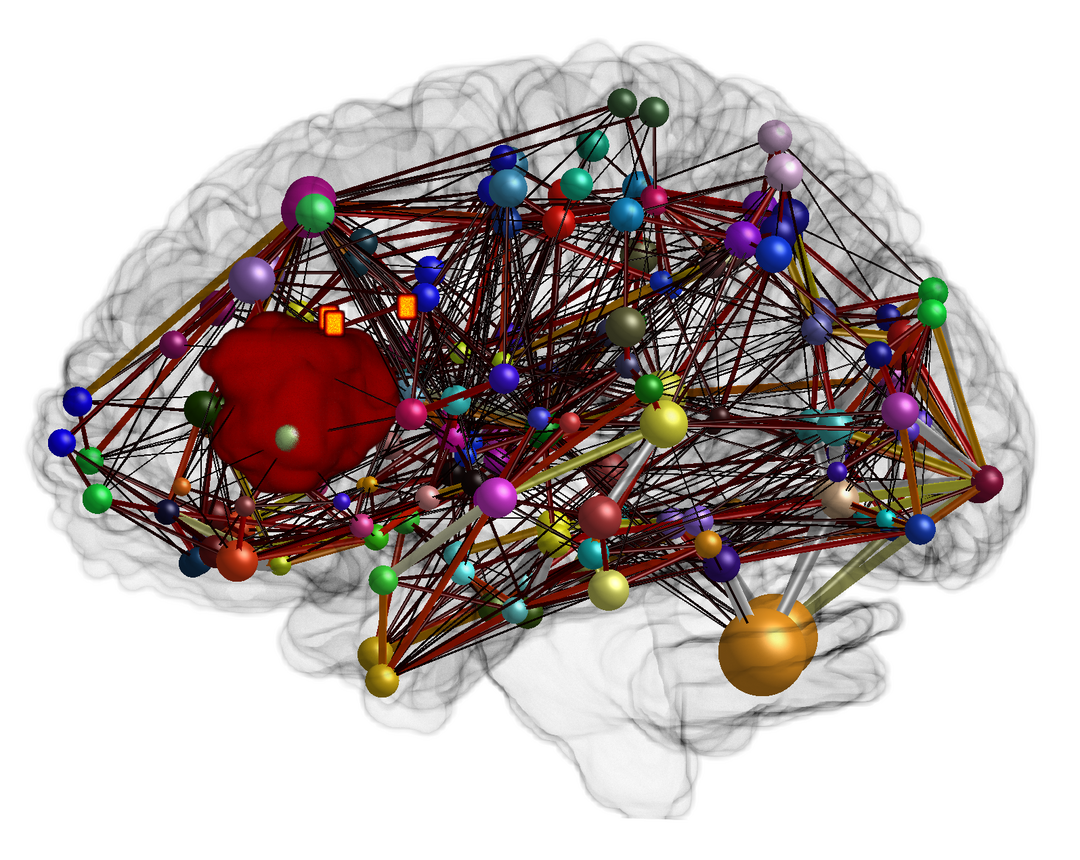|
|
 |
 |
|
|

|
 |
Connectome construction of a patient with a tumor in the speech-eloquent area of the brain. Copyright: Lucius Fekonja & Image Guidance Lab, Charité – Universitätsmedizin Berlin, adapted by Matters of Activity
|
|
Editorial Dear friends of »Matters of Activity«,
In this issue we want to talk about the opportunities and challenges of online teaching and promote interesting events, as usual. Today, we would also like you to take a closer look into the project »Cutting«. Towards the end of this issue, you will find some interesting job opportunities at »Matters of Activity« and beyond.
Happy reading and kind regards,
Antje Nestler, Eva Schmidt and Franziska Wegener
|
 |
|
Liebe Freund*innen von »Matters of Activity«,
in dieser Ausgabe wollen wir über die Chancen und Herausforderungen des Online-Unterrichts sprechen und natürlich, wie immer, auf spannende Veranstaltungen hinweisen. Außerdem möchten wir Sie dazu einladen, mehr über das Projekt »Cutting« zu erfahren. In der heutigen CZ# finden Sie ebenso exzellente Karriere-Chancen innerhalb und außerhalb von »Matters of Activity«.
Viel Spaß beim Lesen und herzliche Grüße
Antje Nestler, Eva Schmidt und Franziska Wegener
|
 |
|
|
|
|
 |
| Open Design – Academic Encounters Online |
 |
|
|

|
 |
Open Design – Academic Encounters Online. Copyright: Matters of Activity
|
|
Master Open Design Announcing the suspension of → Open Design for the summer term 2020 was a very difficult decision. We were all super excited to start the program with a fantastically diverse group of 19 international students from 15 different countries that already had arrived or were about to arrive to Argentina and 13 Argentinean students waiting in Buenos Aires for the program to start in two weeks' time. But with universities and international borders closing, travel authorizations for lectures being withdrawn, flights cancelled and people around the world confined to their homes, it became clear that we wouldn't be able to start face-to-face considering first of all the safety and wellbeing of students, faculty and staff.
But this crisis has also highlighted once more that global challenges and complex problems cannot be solved individually. Hence, we decided not only to suffer the restrictions and negative impacts of the current situation, but instead start to build the Open Design community and establish collaborative structures with the students.
On May 14th, 2020 we launched »Open Design – Academic Encounters Online«. In this first of upcoming monthly sessions and hopefully even a more intensive format towards October, we wanted to demonstrate how Open Design operates and take the current situation as an object of research. The two program directors → Prof. Wolfgang Schäffner and Prof. Arq. Rodrigo Martin Iglesias talked on the topics of masks and confinement, followed by a discussion and exchange of experiences with the participants. While Prof. Schäffner discussed different uses and types of face masks, cultural differences and the shift from an individual artifact towards a populational object, Prof. Martin Iglesias talked about different notions of confinement in the historical and present-day context of disease, social/economic inequality and social security. Furthermore, he addressed aspects of circulation and mobility and regional variations in terms of containment strategies and reactions based on spatial structures.
The current crisis has accelerated the implementation and acceptance of remote teaching and learning and many programs have moved completely online. Besides the challenges of adapting the curriculum and ensuring reliable access for all stakeholders involved, we still think that one of the central aspects of Open Design, however, is the student and staff mobility that offers invaluable exposure to different disciplinary and educational approaches that depend on physical presence and active engagement. Nevertheless, Academic Encounters Online aims to establish virtual mobility as an added collaborative space. These upcoming encounters are open for participation and voluntary engagement. If you would like to contribute to an online discussion within the context of Open Design, give a presentation, facilitate an activity or get involved in any other way, please feel invited to reach out to: info.master-open-design@hu-berlin.de.
|
 |
|
|
|
|
 |
| New Project Website »Cutting« |
 |
|
|

|
 |
Fiber tractography delineating the white matter of the brain. Copyright: Lucius Fekonja, adapted by NODE Berlin Oslo.
|
|
Cutting Again we would like to make you aware of some new interesting material on our website. Today, we would like to invite you to take a closer look into the project »Cutting« and their brand new project website. We hope you enjoy learning more about the project.
Cutting is one of the oldest cultural practices. It is a fundamental way for human beings to enter into correspondence with materials. With these specific gestures and tools, people alter and reshape material boundaries and intertwine different entities. Those activities span across wide forms of tacit knowledge, from ancient craftsmanship to current high-tech procedures. In the domain of art, the cutting of text, music or film material produces new compositions that can provoke new insights. Similarly, in the domain of medicine, surgeons cut the body to understand and to heal it. Embedded in the way we think, write and speak, the act of cutting is ubiquitous: it means distinguishing and choosing between ›good‹ and ›bad‹ in a multitude of symbolic ways. A key component in cultural techniques, cutting is located at the interface between analog and digital technologies. Selecting this operation as a starting point opens up new perspectives, interactions and functions, whose limits and possibilities must be understood both practically and theoretically. → more
|
 |
|
|
|
|
 |
| Encounter with the Digital Twin of our Brain |
| Article About the Experimental Setting »Adaptive Digital Twin« |
 |
|
|

|
 |
Connectome construction of a patient with a tumor in the speech-eloquent area of the brain.
The connection strengths of the white matter are shown as edges with a heat map (dark = weak connection, light = strong connection). The cortical areas of the brain and their size are illustrated as nodes in the form of spheres. Additionally, three orange TMS points are shown (TMS = Transcranial Magnetic Stimulation). In this case, the patient's speech network could be non-invasively disturbed in these areas and mapped accordingly.
The visualization of the white matter is based on tractography. The different directions of the white matter can be measured and displayed by means of diffusion-weighted magnetic resonance imaging. Copyright: Lucius Fekonja & Image Guidance Lab, Charité – Universitätsmedizin Berlin
|
|
Press At one of the research stations in the soon to be open Humboldt Laboratory, visitors will take a look into the human brain. 3D models of this complex organ are shown as holographic representations and in clinical practice, such visualizations support the preparation of operations.
You will find the detailed article in German ↗ here and more information (in English) on our → MoA Cutting Website.
|
 |
|
|
|
|
 |
| HU joins DEAL Springer Nature Agreement |
 |
|
Publication On February 26th, 2020 the HU joined the ↗ DEAL Springer Nature Agreement. For the period from 2020 to 2022, full text access to around 1.900 Springer journals is thus still guaranteed.
If you are a correspondent author at the HU, you have also been entitled to publish your articles open access at no additional cost in the journals requiring subscription since January 1st, 2020.
The offer applies to manuscripts published online by Springer between January 1st, 2020 and December 31st, 2022.
For publications in Springer Nature Open Access journals, as a correspondent author at Humboldt-Universität you will receive a 20% discount on publication fees from August 1st, 2020. For publications in Nature Open Access journals an internal discount of 5 % can be granted.
HU Authors are encouraged to use this publication option and to refrain from publishing without an open access component at Springer-Verlag. Together with hundreds of other scientific institutions in Germany, which have joined the previous DEAL agreements with the publishers Wiley and Springer, we are thus making an important contribution to unhindered access to knowledge.
|
 |
|
|
|
|
 |
| Career Opportunity Outside of MoA: Research Assistant for »MixedPlant« |
| HTW is Looking for Research Assistant |
 |
|
Job The research project ↗ MixedPlant aims to develop an intelligent assistance system, which shall help during the planning stage of process facility construction. Therefore, various methods from the domain of artificial intelligence will be utilised.
The project is looking for a Research Assistant part-time (30 hours per week) in pay group E13 with a fixed term contract until June 15th, 2022.
Your profile should contain:
- Obtained scientific degree in an appropriate field (preferably Computer Science with a focus on AI / Data Analytics)
- Solid knowledge in the domain of Artificial Intelligence / Machine Learning (knowledge concerning expert systems is helpful)
- Solid knowledge in math and software engineering
- Advanced knowledge of programming languages (C#, Python, JavaScript, C++)
- Basic knowledge in German is an advantage
- Knowledge and experience in scientific accompaniment of projects
More information can be found here:
in ↗ German
or ↗ English.
The application deadline is July 6th, 2020. ↗ more
|
 |
|
|
|
|
|